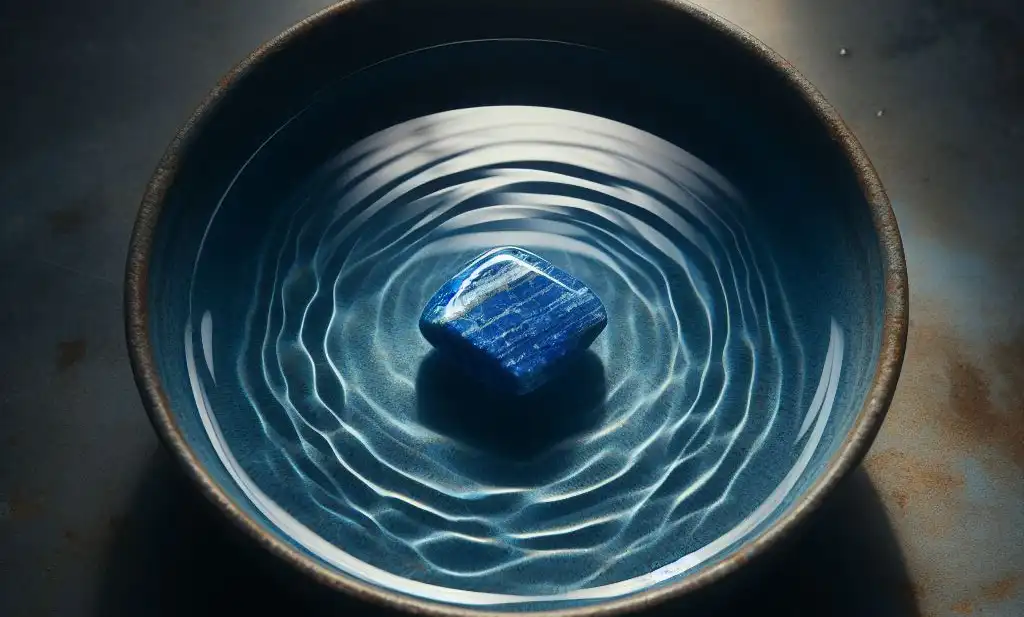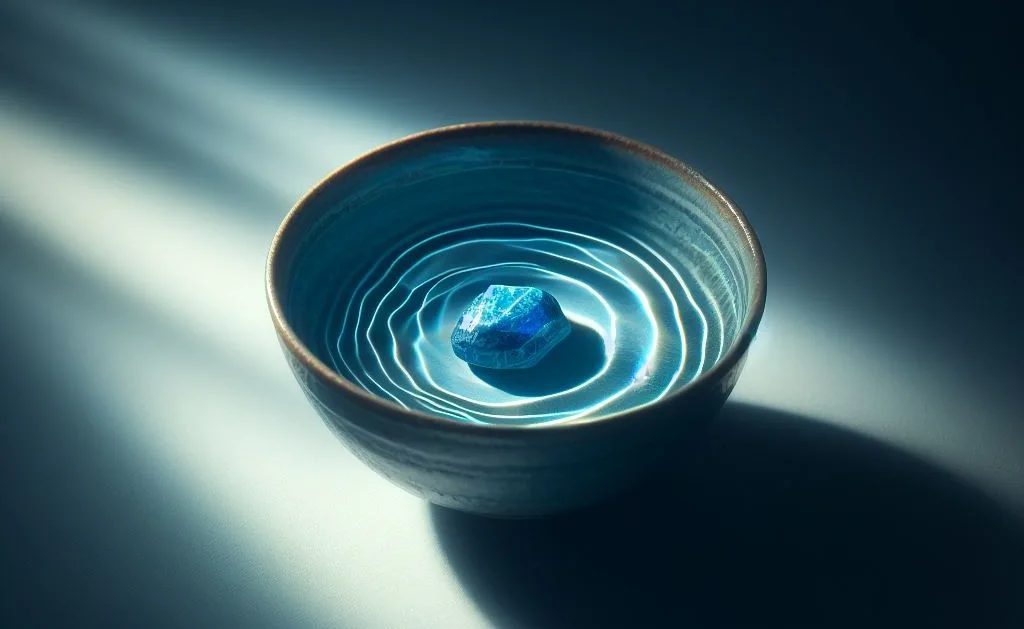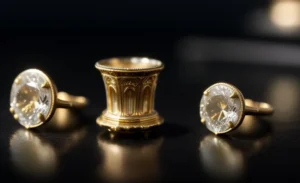Can Lapis Lazuli Go in Water? Lapis Lazuli, a gemstone as ancient as time itself, has captivated humanity with its deep celestial blue, often speckled with pyrite that mimics a starry night.
Yet, one question that frequently emerges among gem enthusiasts and newcomers alike is: Can Lapis Lazuli go in water?
This blog post delves deep into this query, exploring the composition of Lapis Lazuli, its interaction with water, and how to best care for this timeless gemstone.
Can Lapis Lazuli Go in Water?

Lapis Lazuli can go in water, but with caution and only briefly. This beautiful but delicate gemstone, comprised of minerals such as lazurite, calcite, sodalite, and pyrite, has specific vulnerabilities when it comes to water exposure.
The primary concern is the potential for water to dissolve calcite components and alter the gem’s polished surface, leading to a diminished aesthetic appeal.
Therefore, while it is not entirely prohibited to immerse or cleanse Lapis Lazuli with water, such interactions should be infrequent, brief, and undertaken with the utmost care to prevent damage.
This ensures the preservation of the stone’s structural integrity and vibrant appearance, allowing it to be enjoyed for its full historical and visual significance without compromise.
Understanding the Composition of Lapis Lazuli

Lapis Lazuli is a fascinating rock, not just for its stunning blue hue but also for its complex composition. It’s a composite material made up of several key minerals. Lazurite is the primary component, responsible for the gemstone’s signature rich blue color.
Calcite, appearing as white streaks or layers, adds contrast and complexity to the stone’s appearance. Sodalite contributes to the depth of the blue coloring, while pyrite, with its metallic luster, creates a sparkle reminiscent of stars against the night sky.
This amalgamation of minerals not only defines Lapis Lazuli’s aesthetic appeal but also influences its physical characteristics, including its density, porosity, and how it interacts with external elements like water. The presence of these various minerals makes each piece of Lapis Lazuli unique, with a distinctive pattern and color intensity.
Understanding this mineralogical makeup is essential for appreciating why Lapis Lazuli requires specific care and handling to maintain its ancient allure.
The Effects of Water on Lapis Lazuli
Water’s impact on Lapis Lazuli goes beyond surface level, posing risks to its structural integrity and aesthetic value. Continuous or repeated water exposure can trigger the dissolution of its calcite content, leading to noticeable discoloration that detracts from the stone’s natural beauty.
Additionally, the absorption of water can induce a loss of the polished finish that Lapis Lazuli is renowned for. More concerning is the potential for water ingress into the stone’s interior, which not only risks the development of cracks but can also cause the stone to split, especially under conditions of rapid temperature change or freezing.
These effects underline the necessity of limiting water contact and highlight the importance of adhering to recommended care practices to preserve the stone’s mesmerizing appearance and structural soundness.
Cleansing Lapis Lazuli with Water: Yay or Nay?
When contemplating the use of water to cleanse Lapis Lazuli, caution is the watchword. Although not entirely off-limits, immersing the stone in water or using water for cleansing should be done sparingly and with careful consideration.
The key is to ensure that any exposure to water is brief and that the stone is not subjected to temperatures that are too cold or too hot, as extreme temperatures can exacerbate potential damage. After any contact with water, immediate and thorough drying with a soft, gentle cloth is essential to prevent moisture absorption.
It’s important to remember that water is not the only, nor the preferred, method for cleansing this sensitive gemstone.
Given its susceptibility to water damage, seeking out alternative cleansing methods that do not involve water is a prudent approach to maintaining the stone’s condition and preserving its enchanting beauty.
Best Practices for Lapis Lazuli Care
To maintain the beauty and integrity of your Lapis Lazuli, it’s important to implement a gentle, mindful approach to its care. Avoid any harsh treatments or environments that could jeopardize its condition.
Specifically, refrain from using ultrasonic cleaners, steam cleaning, or harsh chemicals on the gemstone, as these methods can be too abrasive and cause lasting damage.
Direct exposure to intense sunlight for prolonged periods should also be avoided, as it can lead to fading or weakening of the stone.
Store your Lapis Lazuli in a manner that prevents it from coming into contact with items that may scratch its surface; a dedicated soft pouch or a lined jewelry box is ideal. Handling the stone with clean, dry hands will help prevent the transfer of oils and grime.
Regularly inspect your Lapis Lazuli for any signs of wear or damage, taking immediate action to address any issues that arise. By prioritizing these careful handling and storage practices, you can help ensure your Lapis Lazuli remains a stunning and vibrant treasure.
Alternatives to Water Cleansing for Lapis Lazuli
For those looking to cleanse their Lapis Lazuli without the risks associated with water, several gentle and effective methods are available. Smudging, an ancient practice rooted in Native American traditions, involves burning sage, cedar, or sweetgrass to produce smoke that is believed to clear negative energies from objects and spaces.
This technique can be safely used around Lapis Lazuli, offering an energetic cleansing without physical contact with water. Additionally, the placement of Lapis Lazuli on a selenite slab or near amethyst crystals is another alternative.
Both selenite and amethyst are known for their purifying properties and can help in removing unwanted energies from the Lapis Lazuli, thereby maintaining its vibrational quality and appearance.
These methods provide safe and respectful ways to care for and honor the energetic essence of Lapis Lazuli, ensuring its longevity and beauty without the need for water.
The Role of Lapis Lazuli in Water-Based Rituals
For individuals incorporating Lapis Lazuli into water-based rituals, it’s important to approach the practice with care to prevent any damage to the stone. Although direct water contact is generally discouraged, there are creative ways to include Lapis Lazuli in these rituals without exposing it to potential harm.
One effective strategy is to place the stone in a clear, waterproof bag or container before submerging it in water. This method allows the Lapis Lazuli to participate in the ritual energetically while remaining physically shielded from the water.
Additionally, positioning the stone above or beside the water vessel, rather than in it, can also maintain its involvement in the ritual without risking its well-being.
By adopting these precautionary measures, practitioners can honor the significance of Lapis Lazuli in their spiritual practices while upholding the utmost respect for its natural properties and limitations.
Understanding and Respecting the Limits of Lapis Lazuli
Embracing the exquisite beauty and historical significance of Lapis Lazuli also means acknowledging its vulnerabilities. This gemstone, with its complex composition and porosity, demands a conscientious approach to its care and handling.
Water, while seemingly innocuous, poses a significant risk to Lapis Lazuli, capable of altering its structural and aesthetic integrity. To truly honor and preserve this ancient stone, it is crucial to understand these susceptibilities.
Educating oneself about the specific needs of Lapis Lazuli not only safeguards its physical condition but also respects the cultural and historical heritage it carries.
Being mindful of how and when to expose Lapis Lazuli to certain elements, including water, ensures that its legacy continues to be appreciated without compromising its essence. This respectful awareness is key to maintaining the enchantment of Lapis Lazuli, allowing us to cherish and admire this gemstone in its fullest splendor.
Final Thoughts on Lapis Lazuli and Water Exposure
Navigating the relationship between Lapis Lazuli and water requires a blend of knowledge and caution. This gemstone, steeped in beauty and historical richness, calls for dedicated care to ensure its preservation.
Embracing mindful practices in handling and exposure can safeguard its vibrant allure, allowing its owners to appreciate its magnificence without fear of compromising its structural and aesthetic qualities.
It’s imperative to remember that while Lapis Lazuli can withstand minimal, brief encounters with water, such instances should be approached with careful consideration.
This ensures the gem remains a captivating treasure within any collection, cherished not only for its appearance but also for the historical narrative it embodies.
Keeping Lapis Lazuli’s vulnerabilities in mind, especially its susceptibility to water, allows for a respectful appreciation of its essence, fostering a lasting bond between this ancient gemstone and its admirers.
FAQs
Can I wear my Lapis Lazuli jewelry while swimming or bathing?
It’s not recommended to wear Lapis Lazuli while swimming or bathing. Chlorinated water, saltwater, and even regular tap water can damage the stone over time.
How should I dry my Lapis Lazuli if it gets wet?
If your Lapis Lazuli gets wet, pat it dry gently with a soft, lint-free cloth. Avoid using heat or direct sunlight to dry it.
Can Lapis Lazuli be cleaned with soap and water?
While it’s best to avoid water, if necessary, you can lightly dampen a cloth with water mixed with a very mild soap to gently wipe the surface. Immediately dry with a soft cloth.
Is it safe to use a sonic cleaner for Lapis Lazuli?
Sonic cleaners should not be used on Lapis Lazuli, as the vibrations can cause damage to the stone’s structure.
What is the best way to store Lapis Lazuli?
Store Lapis Lazuli away from other jewelry to prevent scratches. A soft pouch or a fabric-lined jewelry box is ideal for keeping it safe and secure.














































